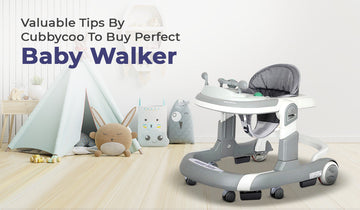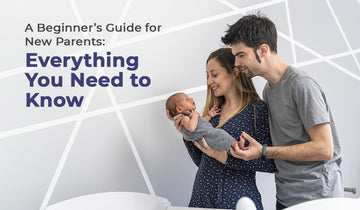Valuable Tips By Cubbycoo To Buy Perfect Baby Walker
When your baby takes their first steps, choosing the right baby walker can make a big difference. A baby walker supports your child's movement and helps develop their muscles, balance, and confidence. At CubbyCoo, we know it can be overwhelming to pick the perfect walker from so many options. That’s why we’ve put together this guide with helpful tips to assist you in making a smart purchase.
1. Safety Comes First
The most important factor when buying a baby walker is safety. Ensure the walker meets global safety standards, such as those from ASTM (American Society for Testing and Materials) or EN (European Norm). A stable, wide base helps prevent tipping, and anti-slip pads are crucial to stop the walker near stairs or uneven surfaces. Look for walkers with built-in safety locks and a braking system to control speed and lower the risk of accidents. Additionally, check for smooth edges, non-toxic materials, and sturdy construction that won’t easily break or collapse.
CubbyCoo Tip:
Always choose walkers that carry JPMA or BIS (Bureau of Indian Standards) certification for safety assurance.
2. Choose the Right Type of Walker
There are different types of baby walkers available, and it’s important to know which one fits your baby’s needs:
- Traditional Seated Walkers: These have a built-in seat and wheels; they are great for babies just learning to stand or move.
- Push Walkers: These are best for babies who can stand and want support while walking around. They encourage better muscle development and posture.
- Convertible Walkers: These can change from a seated walker to a push walker as your baby grows.
CubbyCoo Tip:
For versatility, a convertible walker is a smart long-term investment that grows with your child.
3. Adjustable Height Settings
Every baby grows at a different pace. Walkers with adjustable height settings let you customize the walker to your baby’s current height, ensuring proper foot placement and posture. If your baby's feet don't touch the ground, they won't learn to walk effectively.
CubbyCoo Tip:
Choose a walker that has at least three height adjustment levels to accommodate your baby’s growth.
4. Comfortable & Supportive Seat
A walker’s seat should offer good support and comfort. A padded, high-back seat provides excellent support and encourages an upright posture. The seat should also be detachable and washable to keep it clean.
CubbyCoo Tip:
Removable, machine-washable fabric is best for easy maintenance and cleanliness.
5. Mobility & Wheel Quality
The walker should move smoothly across different surfaces—tiles, wood, carpets—without resistance. Multi-directional swivel wheels in the front allow for better maneuverability, while fixed rear wheels provide stability. For added safety, ensure the wheels have a locking feature to stop the walker when needed.
CubbyCoo Tip:
Rubber or silicone wheels are quieter, protect your floors, and provide better traction than hard plastic wheels.
6. Interactive Play Features
Many baby walkers today come with toys, music panels, and lights that entertain and stimulate babies. These features support sensory development, hand-eye coordination, and cognitive skills. However, avoid choosing a walker that is too distracting and might take your baby's focus away from walking.
CubbyCoo Tip:
Look for detachable activity trays that can also serve as a feeding tray when toys are removed.
7. Material Quality and Durability
A high-quality walker made from BPA-free plastic and strong metal frames ensures durability and long-term use. Weak materials may not endure active baby use and can pose safety risks.
CubbyCoo Tip:
Always perform a stress test—gently press or shake the walker in-store to check for any weak or unstable parts.
8. Portability & Storage
If you have limited space or enjoy traveling, choose a foldable walker. Foldable models save space and are easy to store or transport. Lightweight walkers are also easier for parents to carry.
CubbyCoo Tip:
Check how easy the folding mechanism is—some require only one hand for effortless folding and unfolding.
9. Weight Limit and Age Suitability
Always check the walker’s weight and age recommendations for your baby. Walkers are typically suitable for babies from 6 to 18 months and up to a certain weight (usually around 12-15 kg). Exceeding this limit can affect the walker's performance and safety.
CubbyCoo Tip:
Don’t buy a walker “for the future” that is too big for your baby now—it may do more harm than good.
10. Budget-Friendly Yet Quality-Focused
While cost matters, cheap walkers may compromise quality and safety. Consider investing in a mid-range or premium walker to ensure reliability. Sometimes, expensive models come with features that may not be necessary. Balance your budget with the essential features.
CubbyCoo Tip:
Look for seasonal sales or online discounts from trusted brands for quality products within your budget.
11. Reviews and Brand Reputation
Before making a decision, read online reviews, watch demo videos, and check comments from other parents. A respected brand like CubbyCoo provides quality assurance and offers excellent customer support and warranty services.
CubbyCoo Tip:
Avoid unknown or poorly reviewed brands, regardless of how tempting the price might be.
12. Easy to Clean & Maintain
Babies can be messy! From food spills to diaper leaks, walkers need regular cleaning. Choose models with detachable parts, washable seats, and wipe-clean trays.
CubbyCoo Tip:
Plastic parts should have no small gaps where dirt and bacteria can build up.
13. Encourage Supervised Use
No matter how safe the walker is, babies need to be supervised while using it. A walker is not a babysitter—it’s a tool to assist with walking under parental guidance.
CubbyCoo Tip:
Keep the walker away from kitchen areas, stairways, and bathrooms to reduce potential hazards.
14. Check Return & Warranty Policies
Even with careful selection, a walker may not suit your baby. Ensure the product has a return policy and warranty for peace of mind.
CubbyCoo Tip:
Always save purchase receipts and warranty cards for future claims or replacements.
Final Thoughts from CubbyCoo
A baby walker is not just a toy—it’s a tool that supports your baby's physical and mental growth. Whether you pick a simple push walker or a feature-rich convertible model, always prioritize safety, comfort, durability, and adjustability.
CubbyCoo advises parents to take the time to evaluate their options, check the walker in person when possible, and consider their baby’s unique needs. Every baby is different—what works for one may not work for another. The best walker will combine safety, fun, and support, making your baby’s first steps enjoyable and memorable.
By following these tips, you can find the best baby walker that helps your little one explore the world with confidence and safety.



























